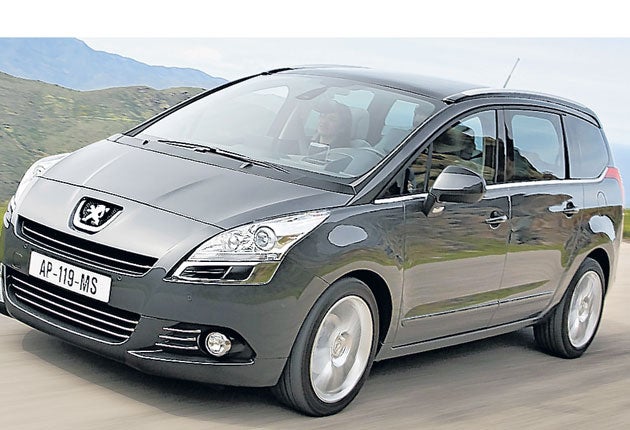Peugeot 5008
Looks aren’t everything with Peugeot’s new 5008

Your support helps us to tell the story
From reproductive rights to climate change to Big Tech, The Independent is on the ground when the story is developing. Whether it's investigating the financials of Elon Musk's pro-Trump PAC or producing our latest documentary, 'The A Word', which shines a light on the American women fighting for reproductive rights, we know how important it is to parse out the facts from the messaging.
At such a critical moment in US history, we need reporters on the ground. Your donation allows us to keep sending journalists to speak to both sides of the story.
The Independent is trusted by Americans across the entire political spectrum. And unlike many other quality news outlets, we choose not to lock Americans out of our reporting and analysis with paywalls. We believe quality journalism should be available to everyone, paid for by those who can afford it.
Your support makes all the difference.Peugeot has never made a unique MPV before. The hefty 806 and 807 people-carriers were/are the same as certain Fiats and Citroëns apart from the badges.
Some of the estate cars with SW suffixes have possessed MPV-like individual rear seats in large-family-friendly quantity, but they are still, at heart, estate cars. Indeed, Peugeot has been a bit of a pioneer of the many-seated station wagon, having long ago sold many of its 504 and 505 familiales to particularly fertile people.
It is this 5-series (with apologies to BMW) that Peugeot wishes to reprise with this latest take on transport for seven. It’s an MPV, as is the modern way, and it is uniquely a Peugeot. True, the new 5008 shares much of its underskin structure and mechanical componentry with the popular Citroën C4 Grand Picasso, but all the parts you see are specific to the 5008.
This is a new development in sibling rivalry within the Peugeot-Citroën (PSA) group. Hitherto, Citroën has done the cars with the wacky shapes while Peugeot has stayed conventional, but with MPVs now so widespread across the size classes they have themselves become a conventional form.
The 5008 also previews a new Peugeot look which spells the end of the gaping-mouth grin which has been growing ever more rictus with each successive model. Its replacement is rather less distinctive. Its meek upper slot and generic under-bumper grillework give the 5008 no individuality at all.
Inside, too, the 5008 is as conformity-minded as its Citroën relative is iconoclastic. There’s no giant windscreen extending into the roof, no futuristic facia, no steering wheel with stationary, switch-bearing hub. All is normal, and very neat with conventional chrome-rimmed dials and some lush padding enlivened by metal highlights, and a strong aura of quality. The sole real innovation is the head-up display as already seen in the 3008, a clear concave plastic panel which rises out of the instrument cowling and on which is projected a digital speedometer and, if desired, sat-nav instructions and a radar-activated warning of when you are too close to the car in front to be able to stop safely. That’s another opportunity for a driver’s judgement to be undermined and to disengage him/her from the task. Some might welcome such a device, but I do not – any more than I like the noisy electric parking brake which, like all of its type, thwarts fine control in close-quarter manoeuvres.
Two petrol engines, both of 1.6 litres, are offered: one with 120bhp, the other a turbo with 156bhp. More people are likely to buy the diesels, available as a 110bhp 1.6 (optionally with a clutchless sequential gearshift), a 150bhp 2.0 or, with automatic transmission only, a 163bhp version of the same. So far, so conventional. Clearly, the 5008’s chief role is to draw those who find a C4 too weird into the PSA fold by alternative means, rather than losing them to the company that invented the modern compact MPV, Renault.
Once behind the wheel of this roomy, airy transport module, with its sliding middle-row seats able to fold fully flat down to floor level (as does the rearmost pair), what awaits the driver? “Enjoyed by families, loved by drivers” is
to be the marketing theme, and it takes just a few bends to realise that there’s rather more talent lurking within the 5008 than the Clark Kent visuals suggest. It’s smooth; it’s quiet; the 2.0-litre turbodiesel is punchy; motion is effortless. More than that, though, the lofty, hefty 5008 – from £16,895 to £23,695 – flows with a tidiness, a tenaciousness and a confidence through corners. A 5008 will generate few complaints from those not driving it, and unexpected pleasure for the one who is.
Instead, passengers can enjoy looking at the clouds through the vast pane of roof glass (in top Exclusive models, anyway), while those further back get a fine view past those ahead thanks to their higher vantage points.
The 5008 is not an exciting car in itself. Rather it is designed to make all aboard feel good about the world, and – some intrusive technology apart – it succeeds. Even the lowly 1.6 turbodiesel moves with more vigour than you would expect from a small engine in a big car. Mission accomplished, then.
The Rivals
Citroën Grand C4 Picasso 2.0 HDi: from £21,495.
The 5008’s hippie cousin has one of the biggest windscreens in the world. Love it or hate it, it’s a good MPV.
Ford S-Max 2.0 TDCi: from £21,745.
Here is the original driver-pleasing MPV, a sort of Galaxy coupé with seven seats, but precise and responsive to drive. Main snag is excessive width.
Renault Grand Scénic 2.0 dCi: from £22,495.
This extended Scénic is effectively a re-skin of the last one. Nothing wrong with that, as long as its reliability matches its cool looks.
Join our commenting forum
Join thought-provoking conversations, follow other Independent readers and see their replies
Comments